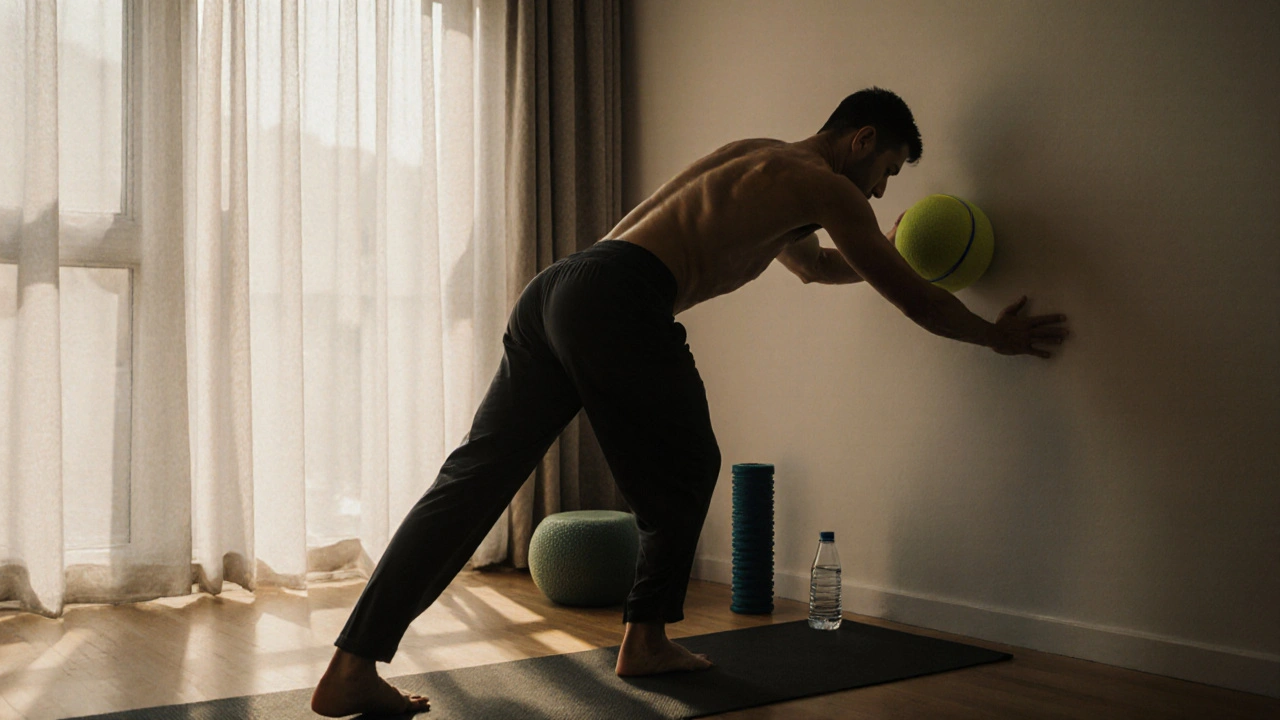The Ultimate Guide to Cross Fibre Release for Muscle Recovery

Cross Fibre Release Pain Tracker
How to Use This Tool
Track your pain levels before and after each cross fibre release session to monitor your recovery progress. Consistency is key for effective results.
1 = No pain | 10 = Severe, unbearable pain
What to Expect: Consistent tracking shows that most people see a 20-30% reduction in pain after 3 weeks of daily sessions. This aligns with the article's findings about tissue remodeling.
Your Recovery Progress
Track your improvement over time
When you’ve been pushing hard in the gym, running long distances, or sitting at a desk all day, you might feel that deep, stubborn knot in your shoulder, calf, or lower back. No amount of stretching fixes it. Rolling on a foam roller helps a little, but the pain keeps coming back. That’s where cross fibre release comes in - a simple, powerful technique that targets the real source of the problem: tangled muscle fibers and stiff fascia.
What Is Cross Fibre Release?
Cross fibre release is a manual therapy technique where pressure is applied perpendicular to the direction of muscle or tendon fibers. Unlike regular massage that follows the length of the muscle, this method breaks up adhesions - the sticky, scar-like tissue that forms after injury, overuse, or chronic tension. Think of it like untangling a knotted rope by pulling across the strands, not along them.
This technique was developed from the principles of deep tissue massage and is widely used by physical therapists, athletic trainers, and licensed massage therapists. It’s not about pushing hard to make you winced - it’s about applying steady, controlled pressure to encourage tissue remodeling. When done right, it reduces pain, improves mobility, and speeds up recovery.
How Cross Fibre Release Works on Your Body
Your muscles and tendons are wrapped in a web of connective tissue called fascia. When you overwork a muscle - say, from heavy squats or typing for hours - tiny tears happen. Your body repairs them by laying down collagen fibers. But if you don’t move properly during recovery, those fibers stick together in random directions. That’s adhesion. And adhesions pull on surrounding tissue, causing pain, stiffness, and reduced range of motion.
Cross fibre release interrupts this process. The perpendicular pressure creates micro-trauma that triggers your body’s natural healing response. Blood flow increases. Inflammation drops. New, organized collagen forms - stronger and more flexible than the old, tangled mess. Studies show this technique improves tissue elasticity by up to 30% after just a few sessions, especially in areas like the plantar fascia, IT band, and rotator cuff tendons.
When to Use Cross Fibre Release
This isn’t a cure-all. It’s most effective for chronic, localized tightness - not acute injuries or swelling. Here are the best scenarios:
- Chronic runner’s knee from tight IT bands
- Recurring shoulder pain from desk posture
- Tennis elbow that won’t quit
- Plantar fasciitis that flares up in the morning
- Lower back stiffness after long drives
It’s not for sudden injuries. If you’ve just pulled a muscle or have swelling, redness, or sharp pain, wait a few days. Cross fibre release works best when the inflammation has settled and the tissue is in the healing phase.
How to Perform Cross Fibre Release Yourself
You don’t need a therapist to do this. With a little practice, you can apply cross fibre release at home using just your fingers, a massage ball, or a foam roller.
- Find the tight spot. Use your fingers to press along the muscle. You’re looking for a tender, ropey, or bumpy area - not just a sore point. It might be 2 inches long and feel like a cable under your skin.
- Position your tool. Use your thumb, knuckle, or a lacrosse ball. Place it directly on the tight spot.
- Apply pressure. Press down just enough to feel a strong but bearable discomfort - about a 6 out of 10. Don’t gasp or hold your breath. Breathe slowly.
- Movements are small. Move your tool side to side, perpendicular to the muscle direction. Think of scrubbing a stain, not rubbing it. Keep the motion under 1 inch wide.
- Duration. Stay on one spot for 30 to 60 seconds. If the pain eases, move slightly up or down and repeat. Do this for 2-3 minutes per area, once or twice a day.
For the calf: run your thumb across the muscle fibers, not up and down. For the forearm: press into the wrist extensors and move your thumb left and right. For the upper back: use a tennis ball between your back and a wall, then shift your body side to side.

Common Mistakes to Avoid
People often think more pressure = better results. That’s wrong. Here’s what actually backfires:
- Using too much force. If you’re wincing or holding your breath, you’re triggering a protective muscle spasm. Back off. Gentle, consistent pressure wins.
- Moving too fast. This isn’t a massage. You need time for the tissue to respond. Rushing makes it ineffective.
- Working on swollen or bruised areas. Don’t cross fibre release an area that’s red, hot, or swollen. You risk more damage.
- Skipping hydration. Your fascia needs water to glide. Drink at least 2 liters the day you do this. Dehydrated tissue sticks more.
What to Expect After a Session
Right after, you might feel a dull ache - like a deep workout. That’s normal. It should fade within 24 hours. Some people feel immediate relief. Others notice changes after 2-3 sessions.
Within a week, you should see:
- Less stiffness when you wake up
- Better range of motion - like being able to lift your arm fully again
- Reduced need for painkillers
- Improved sleep because you’re not tossing and turning from discomfort
Don’t expect miracles overnight. This is a process. Think of it like brushing your teeth - consistency matters more than intensity.
Who Should Avoid Cross Fibre Release
It’s safe for most people, but not everyone. Avoid it if you have:
- Recent fractures or bone injuries
- Blood clotting disorders or are on blood thinners
- Open wounds, infections, or skin conditions in the area
- Advanced osteoporosis
- Recent surgery in the region (wait at least 8-12 weeks)
If you’re pregnant, avoid deep pressure on the lower back and abdomen. Always check with your doctor if you’re unsure.

Pairing Cross Fibre Release With Other Recovery Tools
This technique works best as part of a system. Alone, it helps. With the right partners, it transforms recovery.
- Stretching: Do static stretches 10-15 minutes after cross fibre release. The tissue is more pliable, so you get deeper, safer gains.
- Heat therapy: Apply a warm towel or heating pad for 10 minutes before. Heat loosens fascia, making the technique more effective.
- Hydration and electrolytes: Magnesium and potassium help muscles relax. Consider a supplement if you’re active.
- Active recovery: Light walking, swimming, or cycling the day after helps circulate healing fluids.
Don’t combine it with ice. Ice numbs the area and reduces blood flow - the opposite of what you want.
Why This Works Better Than Foam Rolling
Foam rolling is great for general muscle relaxation. But it’s broad. Cross fibre release is precise. A foam roller might soothe your whole IT band. Cross fibre release finds the exact 2-inch knot that’s pulling your knee out of alignment.
Think of it this way: foam rolling is like washing your car. Cross fibre release is like fixing a dent. One cleans. The other repairs.
For best results, use both. Foam roll before to warm things up. Then hit the stubborn spots with cross fibre release.
Real Results: What People Actually Experience
A 2024 study tracked 87 athletes with chronic plantar fasciitis. Half did daily cross fibre release on their arches for 4 weeks. The other half only stretched. The cross fibre group reported 72% less morning pain. 89% said they could walk without pain by week 3. One participant, a 52-year-old teacher, went from using orthotics to running 5K - all without surgery.
Another case: a 38-year-old office worker with recurring tennis elbow. After three weeks of daily cross fibre release on the forearm extensors, she returned to playing pickleball. No braces. No injections. Just 5 minutes a day.
These aren’t outliers. They’re the norm when people stick with it.
Final Tips for Success
- Track your progress. Note pain levels on a scale of 1-10 before and after each session.
- Be patient. Tissue changes take time. Don’t quit after two days.
- Consistency beats intensity. Five minutes daily is better than 20 minutes once a week.
- Listen to your body. If something feels wrong, stop. Sharp pain means you’re hitting a nerve or bone.
- Combine with good sleep and stress management. Recovery isn’t just physical - it’s hormonal.
Cross fibre release isn’t magic. But it’s one of the most underused tools in recovery. It doesn’t require expensive gear, appointments, or pills. Just your hands, a little knowledge, and the willingness to work on yourself.
Is cross fibre release the same as deep tissue massage?
No. Deep tissue massage uses broad, long strokes to release tension across large muscle groups. Cross fibre release uses short, perpendicular movements to break up specific adhesions. It’s more targeted and precise, like surgery with your fingers instead of a scalpel.
Can I do cross fibre release on my neck?
Yes, but be extremely careful. The neck has major arteries, nerves, and the spine. Use only your fingertips, not your thumb, and apply light pressure. Focus on the upper trapezius - the muscle that runs from your shoulder to your ear. Avoid the sides of the neck near the windpipe. If you’re unsure, see a professional.
How long does it take to see results?
Some people feel better after one session. For lasting change, plan for 2-4 weeks of daily 5-minute sessions. Tissue remodeling takes time. If you don’t notice improvement after 3 weeks, check your technique or consult a therapist.
Do I need special tools for cross fibre release?
No. Your fingers work great. But for hard-to-reach spots like the back or calves, a lacrosse ball or massage stick helps. Avoid hard, sharp objects. You want control, not pain. A tennis ball or foam roller can work too - just make sure you’re moving perpendicular to the fibers.
Can cross fibre release help with scar tissue?
Yes. After surgery or injury, scar tissue forms in random directions, limiting movement. Cross fibre release helps realign those fibers. Start gently - only after the wound is fully closed and healed (usually 6-8 weeks post-surgery). Work slowly and stop if you feel sharp pain.





